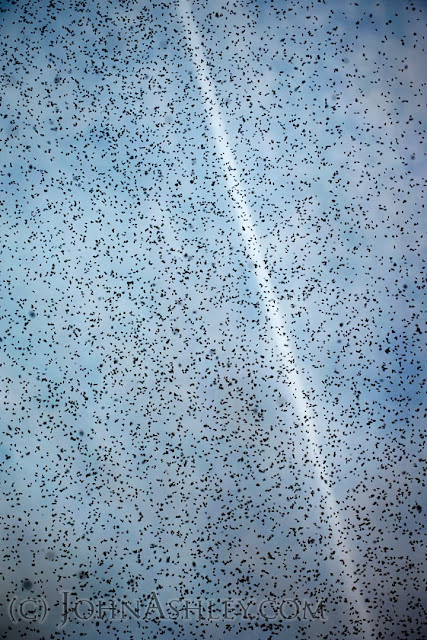 |
| Nuptial cloud of mating ants over Lone Pine State Park |
That was more than a dozen years ago. Just a few springs ago, we watched a massive cloud of tiny ants swarming over the rocky peak at Lone Pine State Park. And a few days ago, our neighborhood carpenter ants launched into their annual swarm here at 3,900' elevation. These are just several of at least 76 different ant species living in Montana. The reality might be double that number.
For some ant species, swarming males and females from different colonies embrace mid-air, tumbling slowly to the ground in a frenetic nuptial fervor. For other species, all of the males from local colonies fly to a specific location and wait on the ground for females to arrive, similar to bird breeding leks. Virgin queen ants land to be mobbed by competing males, but she determines the 1-4 males she'll mate with before ending the tango with a squeaking "female liberation signal" that sends the males scurrying away. She'll fly off to excavate a new nest, and the males will all be dead in a day or two.
 |
| One tiny ant from the cloud photo above |
Most ant colonies consist of one queen and her daughters who tend to her, gather or grow food, defend against outsiders, and generally run the nest. Successful queens live for about five years, using sperm stored from her single nuptial flight to fertilize a lifetime of eggs.
Maybe one in 5,000 dispersing queen ants will survive the gauntlet of predators that includes birds, dragonflies, wasps, frogs, lizards, beetles, spiders, and more. But probably the most widespread danger is death from landing in another ant colony's territory, which is viciously defended by female workers.
A rare surviving new queen excavates a nest, lays eggs and raises a batch of daughters. The daughters then take over day-to-day operations and the queen focuses on producing eggs. All of her daughters have the exact same genetics, and the factors that determine which daughters will become new queens are strictly environmental.
 |
| Virgin queen carpenter ants ready to fly |
Males, of course, are another story.
Fertilized eggs always produce daughter ants. But unfertilized eggs turn into small, winged males. They only live for a few weeks, and they only have one job. They wait around inside the nest for that fateful day when they'll rush out in a frenzy with their winged sisters. All of the queen's sons leave home in search of females from other nests to mate with during the brief swarm. Only a portion of them will find females to mate with, and only a tiny proportion will win the struggle to pass their genetic material forward.
But if you think about it, every single ant you'll ever see is the direct descendant of an over-achieving ant ancestor. The short ancestor who succeeded in spite of the long odds against it. Is this amazing enough for us to give a little credit where credit's due when our next picnic is interrupted?
 |
| Small spider captures a large, winged ant meal |

